
Kyoto Handicraft Center


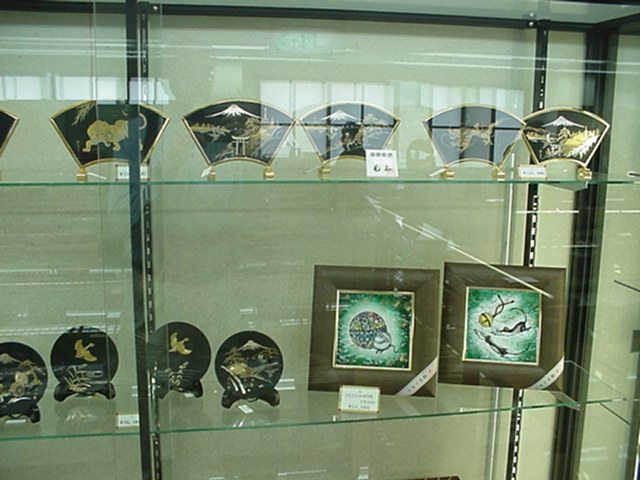 The Kyoto Handicraft Center is a one-stop
shopping solution for visitors in Japan. This seven story
building contains the finest examples of Japanese crafts
from all over the island. Tours begin at the seventh floor
and work their way down. The seventh floor presents crafts
manufactured and distributed by Amita Corporation. Their
products include Damascene, Cloisonné, and pearls. This
floor focuses primarily upon the Damascene boxes and plates,
and includes a view of the craftsmen's work area. The photo
to the left shows one such craftsman laboring on a Damascene
box, while the photo to the right shows one of the many
showcases featuring the finished products.
The Kyoto Handicraft Center is a one-stop
shopping solution for visitors in Japan. This seven story
building contains the finest examples of Japanese crafts
from all over the island. Tours begin at the seventh floor
and work their way down. The seventh floor presents crafts
manufactured and distributed by Amita Corporation. Their
products include Damascene, Cloisonné, and pearls. This
floor focuses primarily upon the Damascene boxes and plates,
and includes a view of the craftsmen's work area. The photo
to the left shows one such craftsman laboring on a Damascene
box, while the photo to the right shows one of the many
showcases featuring the finished products.

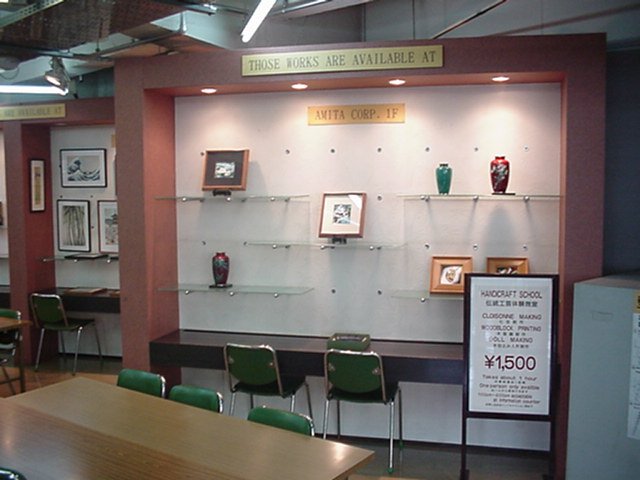 The sixth floor has more
of a hands-on motif, as it is the area which houses the
handicraft center classes, as well as the cafeteria. Classes
are offered in Cloisonné making, woodblock printing, and doll
making, all traditional Japanese crafts passed down from
generation to generation. The photo to the left is an example
of one of the simpler dolls on display, while the photo to the
left shows some of the other crafts created in the classes;
the display is a bit thin, as we went during the winter months
when business is understandably slow. The fifth floor also
offers a buffet featuring all of your favorite Japanese
dishes, including udon noodles, tempura, sushi, and the
ubiquitous green tea. A great place to fuel up before you shop
till you drop!
The sixth floor has more
of a hands-on motif, as it is the area which houses the
handicraft center classes, as well as the cafeteria. Classes
are offered in Cloisonné making, woodblock printing, and doll
making, all traditional Japanese crafts passed down from
generation to generation. The photo to the left is an example
of one of the simpler dolls on display, while the photo to the
left shows some of the other crafts created in the classes;
the display is a bit thin, as we went during the winter months
when business is understandably slow. The fifth floor also
offers a buffet featuring all of your favorite Japanese
dishes, including udon noodles, tempura, sushi, and the
ubiquitous green tea. A great place to fuel up before you shop
till you drop!
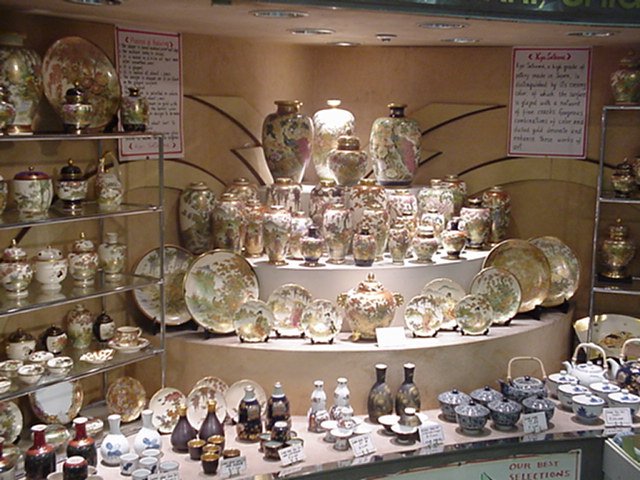
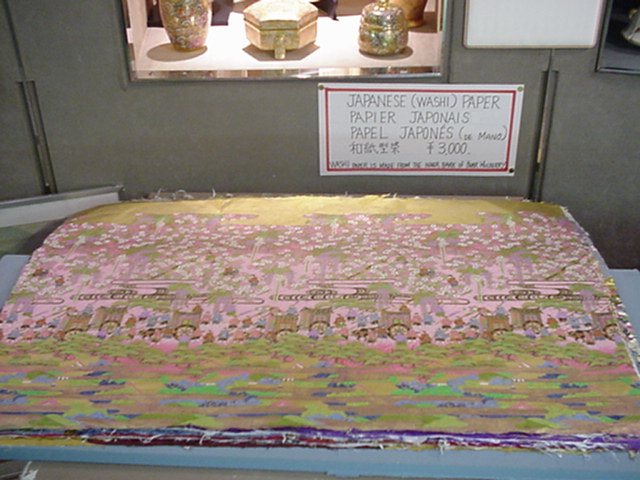 The fifth floor is
shared by Amita Corporation and Heian Cloisonné Company. The
former has both Damascene creations and kimonos on display,
while the latter has a very elaborate display of their
pottery. The photo to the left shows one of the
Cloisonné pottery displays, while the photo to the right shows
a scene painted on paper made from the bark of the mulberry
tree.
The fifth floor is
shared by Amita Corporation and Heian Cloisonné Company. The
former has both Damascene creations and kimonos on display,
while the latter has a very elaborate display of their
pottery. The photo to the left shows one of the
Cloisonné pottery displays, while the photo to the right shows
a scene painted on paper made from the bark of the mulberry
tree.
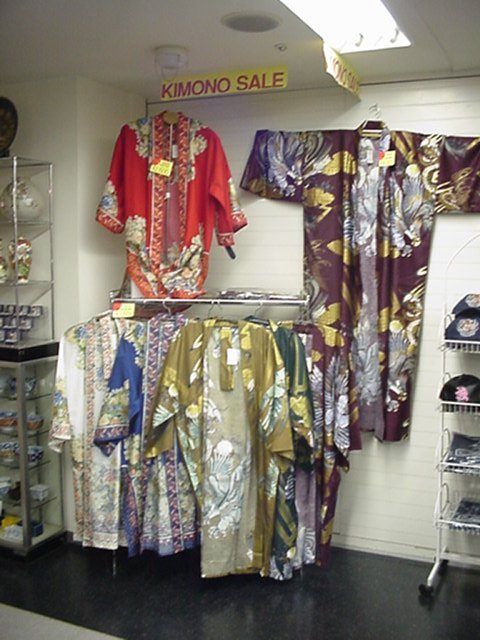
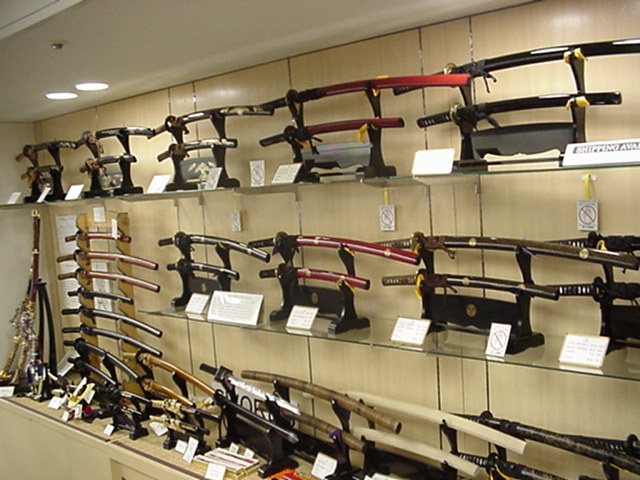 The fourth floor is
host to an eclectic variety of crafts. Nearly half of the
floor space is occupied by the Kyoto Silk Company; the
company has a full range of scarves, handkerchiefs,
headbands and even kites, as shown in the photo to the lower
right. The kimonos shown in the photo to the left are silk
and are made by the Kyoto Kimono Company. Occupying one wall
of the fourth floor (and a bit out of character with the
rest of the handicrafts on the floor) is an impressive
selection of ceremonial swords (photo the right). The fourth
floor also hosts the workshops of the Nakayama Doll
Manufacturing Company, and visitors can watch the craftsman
putting the finishing touches on the porcelain dolls. The
dolls, dressed in silk, reflect
traditional Japanese values; the dolls normally portray
women in Geisha and Kabuki costumes, as in the showcase
shown in the photo below to the left. This particular company has been creating these
dolls for 350 years
The fourth floor is
host to an eclectic variety of crafts. Nearly half of the
floor space is occupied by the Kyoto Silk Company; the
company has a full range of scarves, handkerchiefs,
headbands and even kites, as shown in the photo to the lower
right. The kimonos shown in the photo to the left are silk
and are made by the Kyoto Kimono Company. Occupying one wall
of the fourth floor (and a bit out of character with the
rest of the handicrafts on the floor) is an impressive
selection of ceremonial swords (photo the right). The fourth
floor also hosts the workshops of the Nakayama Doll
Manufacturing Company, and visitors can watch the craftsman
putting the finishing touches on the porcelain dolls. The
dolls, dressed in silk, reflect
traditional Japanese values; the dolls normally portray
women in Geisha and Kabuki costumes, as in the showcase
shown in the photo below to the left. This particular company has been creating these
dolls for 350 years
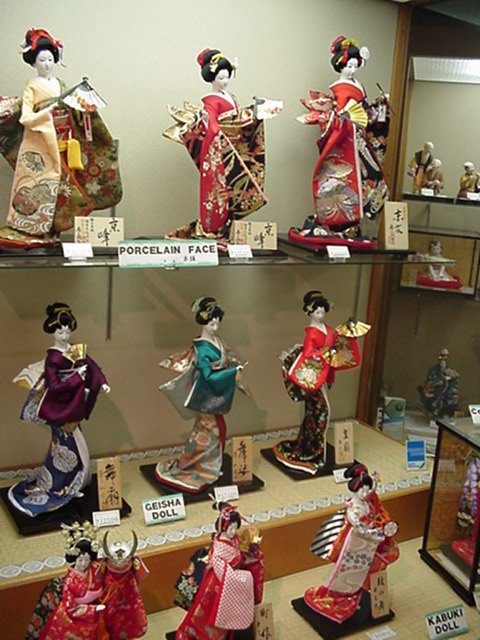
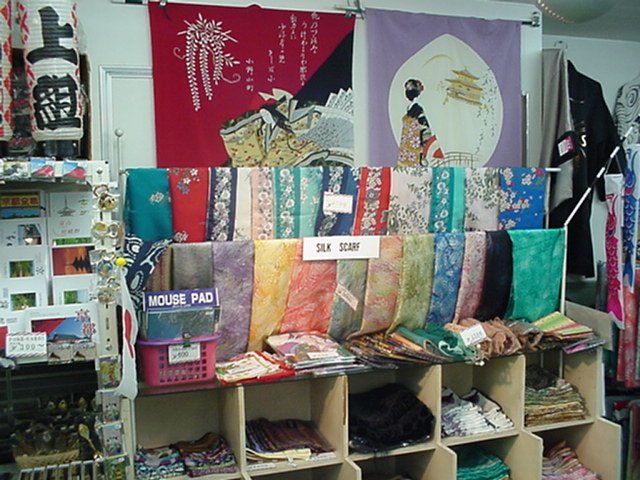
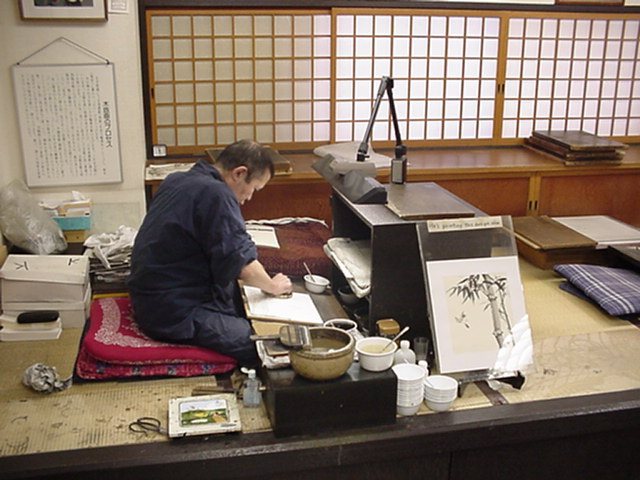
 The Uchida Art Company occupies the bottom three
floors of the Kyoto Handicraft center. The third floor is devoted to one of the most
beautiful Japanese crafts, printing; it focuses exclusively on
woodblock printing, and has an area where you can watch the
craftsman at work. (photo to the left) The prints themselves
range from postcard to wall-sized hangings, and are in color
as well as black and white. The photo to the right shows some
examples of the finished prints.
The Uchida Art Company occupies the bottom three
floors of the Kyoto Handicraft center. The third floor is devoted to one of the most
beautiful Japanese crafts, printing; it focuses exclusively on
woodblock printing, and has an area where you can watch the
craftsman at work. (photo to the left) The prints themselves
range from postcard to wall-sized hangings, and are in color
as well as black and white. The photo to the right shows some
examples of the finished prints.
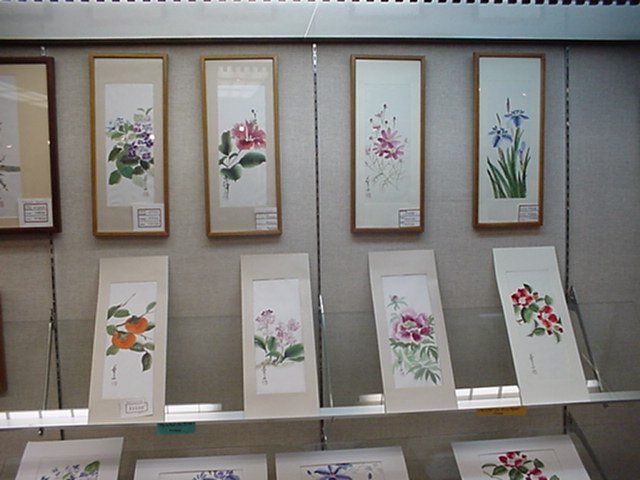
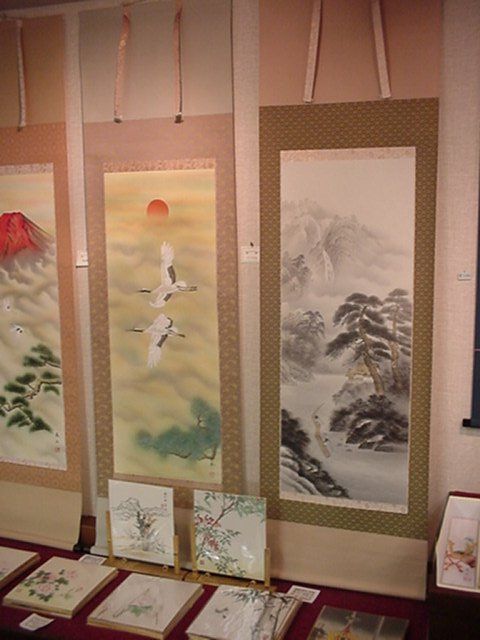 The second floor also features the block
printing technique, but this time it is used to make the
larger scrolls which are a common decoration in Japanese
homes. The photo to the left shows the small framed floral
prints, while the photo to the right shows the larger
wall-hanging scrolls that feature traditional landscapes.
The second floor also features the block
printing technique, but this time it is used to make the
larger scrolls which are a common decoration in Japanese
homes. The photo to the left shows the small framed floral
prints, while the photo to the right shows the larger
wall-hanging scrolls that feature traditional landscapes.
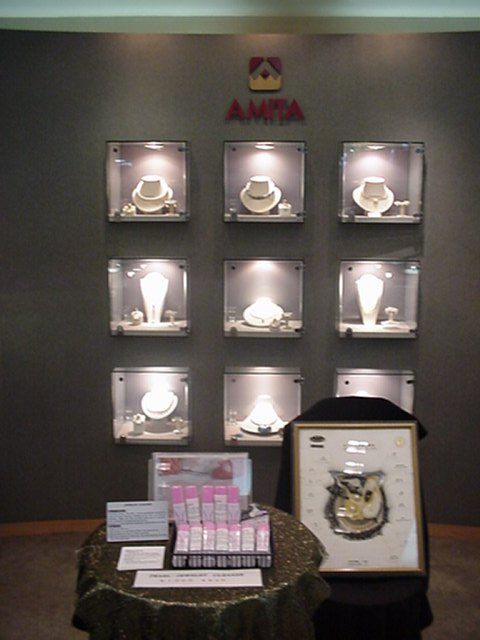
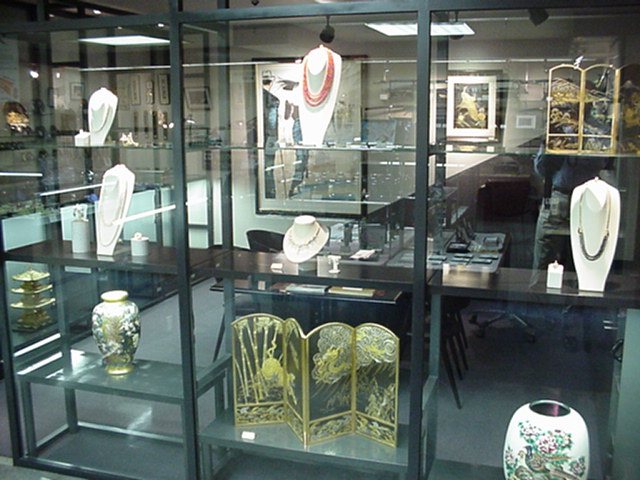 The first floor, shared by
Uchida Art Company and Amita Corporation, feature the painted
screens of the former, and the pearls of the latter. The pearl
display cases, pictured in the photos to the right and the
left, make an impressive introduction to the Kyoto Handicraft
Center.
The first floor, shared by
Uchida Art Company and Amita Corporation, feature the painted
screens of the former, and the pearls of the latter. The pearl
display cases, pictured in the photos to the right and the
left, make an impressive introduction to the Kyoto Handicraft
Center.
[Return
to Menu at Top of the Page]








